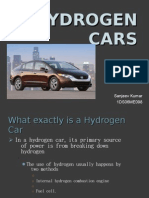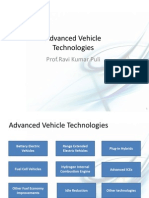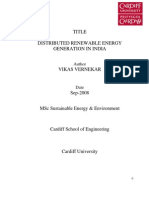Hydrogen As An Alternative Fuel
Hydrogen As An Alternative Fuel
Uploaded by
Purna Satria NugrahaCopyright:
Available Formats
Hydrogen As An Alternative Fuel
Hydrogen As An Alternative Fuel
Uploaded by
Purna Satria NugrahaOriginal Description:
Original Title
Copyright
Available Formats
Share this document
Did you find this document useful?
Is this content inappropriate?
Copyright:
Available Formats
Hydrogen As An Alternative Fuel
Hydrogen As An Alternative Fuel
Uploaded by
Purna Satria NugrahaCopyright:
Available Formats
Hydrogen As an Alternative Fuel
by Peter Kushnir
Hydrogen is the ideal alternative fuel for Army After Next (AAN) platforms. However, while
hydrogen offers many benefits, there are two drawbacks to using it as a fuel with current
technology. Liquid hydrogen, the preferred form of hydrogen, requires four times the storage
space of conventional petroleum-based fuels. The other problem is that hydrogen production
depends on the availability of a nonrenewable resource, petroleum. Currently, hydrogen is
produced from raw petroleum for industrial use, but petroleum supplies may become limited in
the near future.
Liquid hydrogen is the best alternative fuel for AAN platforms; however, further research is
needed to move the hydrogen fuel technologies from prototypes to usable military hardware and
to optimize power outputs from internal combustion engines (ICE's), gas turbine engines, and
fuel cells.
Petroleum production is expected to decrease significantly by 2025, the year that AAN concepts
and force structures are scheduled to be operational. Current oil production is 25 billion barrels
of oil per year; by 2025, annual oil production most likely will be between 18 and 19 billion
barrelsless than the annual production during the oil shortages of the 1970's. The predicted
decrease, as well as possible interruption of imported oil due to political instability in the Middle
East, will result in increased petroleum prices.
On the other hand, high speed and high mobility will characterize the AAN battle force, and
speed and mobility mean high fuel consumption. The 1998 AAN Annual Report states, "An
absolute imperative exists to develop alternative fuels (nonfossil) . . . for AAN-era forces." The
report goes on to say that there are numerous alternatives to fossil fuels but does not specify what
those fuels are. In the January-February 1999 issue of Army Logistician, Lieutenant Colonel
Allen Forte recommends " . . . new systems [ought] to examine alternatives to fossil fuels as their
first option for a power source." Other writers have recommended that AAN planners develop
hydrogen as the fuel for AAN platforms; one unequivocally states, "The development of
hydrogen-based vehicles is a national imperative."
The Attributes of Hydrogen
Hydrogen is considered an alternative fuel for two reasons: It is renewable, and it is the most
abundant element on the earth. Hydrogen comprises more than 75 percent of the environment; so
if it became a primary fuel, dependence on foreign sources of fuel would be eliminated.
However, hydrogen in nature exists primarily in combination with other elements. For hydrogen
to be useful as a fuel, it must exist as free hydrogen (H
2
). One common source of hydrogen is
water, which is 11.2 percent hydrogen by weight. Hydrogen also can be produced from biomass.
Biomass is essentially plant matter, so the vast agricultural resources of the United States could
be used to "grow" the fuel required by AAN platforms.
Hydrogen's Characteristics
Hydrogen's physical and chemical properties make it a good candidate for a fuel. At normal
atmospheric conditions, hydrogen is a colorless and odorless gas. It is stable and coexists
harmlessly with free oxygen until an input of energy drives the exothermic (heat releasing)
reaction that forms water. Fuel cells also may use hydrogen as a fuel. A fuel cell is an
electrochemical engine that converts the chemical energy contained in the hydrogen molecule
into electrical energy. Hydrogen can react with oxygen to produce electricity in a fuel cell.
Hydrogen is the lightest element occurring in nature and contains a large amount of energy in its
chemical bond. Because of its low density, liquid hydrogen weighs less than petroleum-based
fuels. The density of gaseous hydrogen is 0.0899 grams per liter (g/l). (Air is 1.4 times as dense.)
Liquid hydrogen boils at -252.77 degrees Celsius, and it has a density of 70.99 g/l. With these
properties, hydrogen has the highest energy-to-weight ratio of all fuels: 1 kilogram (kg) of
hydrogen has the same amount of energy as 2.1 kg of natural gas or 2.8 kg of gasoline. Hydrogen
burns in air at concentrations in the range of 4 to 75 percent by volume (methane burns at 5.3 to
15 percent concentrations by volume). The highest burning temperature of hydrogen is 2,318
degrees Celsius and is reached at 29-percent concentration by volume in air.
These data give hydrogen both advantages and disadvantages. The major advantage is that
hydrogen stores approximately 2.8 times the energy per unit mass as gasoline. The disadvantage
is that it needs four times the volume for a given amount of energy. For example, a 15-gallon
tank of gasoline contains 90 pounds of gasoline; a 60-gallon tank of gaseous hydrogen would
weigh only 34 pounds. Hydrogen has the potential to reduce the amount of fuel consumed by
AAN platforms, but the size of the storage container would increase.
Extraction and Use of Hydrogen Energy
There are two ways to extract the energy contained in hydrogen: by simple combustion in ICE's
or turbine engines or by converting it to electricity in a fuel cell.
Daimler-Benz AG (now DaimlerChrysler), BMW, and Mazda have developed and tested ICE's
fueled with hydrogen and have concluded that hydrogen can be used successfully as a vehicle
fuel. Hydrogen also can be used to power aircraft gas turbines. In 1988, a triple-jet-powered,
modified Tupolev-154 airliner was flown in the former Soviet Union using liquid hydrogen as a
fuel. Daimler-Benz Aerospace Airbus (DASA), in cooperation with Russia, is developing a
liquid-hydrogen-powered aircraft. The only drawback is that adjustments in manufactured parts
and components will be necessary to handle the cryogenic liquid hydrogen. The cryogenic
temperature range is from -150 degrees Celsius (-238 degrees Fahrenheit) to -273 degrees
Celsius (-460 degrees Fahrenheit).
Fuel cell drive concepts with highly efficient electric drive systems can provide fuel-efficient
solutions for vehicle propulsion that are two to three times as efficient as ICE's with mechanical
transmission systems. Fuel cells convert chemical energy directly to electricity, so they lose less
energy to waste heat than ICE's. The electrical output of fuel cells can power an electric motor,
and vehicles with fuel cells are being developed and tested.
Several types of fuel cells are being developed. The proton-exchange membrane (PEM) fuel cell
generally is considered the most promising fuel cell for automotive use, such as light trucks. The
PEM fuel cell has a low operating temperature, which enables quick starts, and the amount of
power it generates for its weight and size (power density) is high enough for light-duty trucks.
Several experiments are being conducted in Germany using PEM-fuel-cell-powered buses. The
fuel cells, coupled with electric drive motors, are able to move 18-metric-ton buses efficiently
and reliably.
Production
Unlike fossil fuels that can be mined or extracted, hydrogen must be produced. Hydrogen can be
produced from a variety of feedstocks, including oil, coal, natural gas, biomass, and water.
The main feedstock for hydrogen is natural gas, because the efficiency is high and the production
cost is relatively low. Other feedstocks that are used to produce hydrogen are coal and residual
oil from the treatment of crude oil. However, any process producing hydrogen from
petrochemical-based feedstock does not reduce dependence on foreign oil.
Hydrogen production from biomass, though promising, is still in the early research and
development phase. Basically, biomass includes all organic substances, such as plants, wood
chips, bales of straw, liquid manure, and organic wastes. Currently, there is no commercially
available process for producing hydrogen from biomass, but the method is to use a high-
temperature process to convert biomass into hydrogen and carbon dioxide.
Electrolysis can be used to separate water into its basic constituents, hydrogen and oxygen. In
electrolysis, a current is passed through water. Although any power source can be used to
produce the electric current, hydroelectric resources offer the lowest price for hydrogen
production.
Storage
Hydrogen may be stored on platforms using a variety of technologies. At room temperature,
hydrogen is a gas that can be stored in compressed gas cylinders similar to those used on natural-
gas-powered vehicles. Gaseous fuels contain comparatively little energy per unit volume, so
platforms using gaseous hydrogen may have a somewhat reduced range compared to platforms
using liquid fuels such as gasoline or diesel. Hydrogen also may be stored in liquid form, but it
becomes a liquid only at very low temperatures, so special fuel tanks are necessary to keep the
hydrogen cold and prevent losses.
Compressed-gas cylinders made of stainless steel are being used for storing fuel aboard natural-
gas-powered automobiles. These cylinders have a pressure level of 20 megapascals (MPa), or
2,900 pounds per square inch (psi). The pressure levels desired for on-board storage range from
20 to 30 MPa, or 4,350 psi. Under development are high-pressure cylinders made of plastic
composite structural materials with steel or aluminum liners, to be used for liquid hydrogen.
Liquid hydrogen storage is preferred to compressed gas storage since more hydrogen can be
stored in the liquid state than in the gaseous state. Tanks for cars and buses are available as
individually manufactured items. Small vacuum tanks with a 100-liter capacity are available with
a super insulation consisting of some 30 aluminum foil layers separated by plastic foil. Larger
tanks consist of three elliptical cross-section tanks, each with a 190-liter capacity. The tanks are
constructed with 200 to 300 layers of insulating foil. Evaporation rates (evaporation of liquid
hydrogen into gaseous hydrogen) for both tanks are on the order of 1 percent per day.
Transport
Both compressed gaseous hydrogen and liquid hydrogen can be transported by trucks or rail.
Liquid hydrogen can be transported in pressurized tanks by truck, rail, barge, or ship. Insulation
of the storage tanks is of utmost importance. Due to the very low boiling point of hydrogen,
losses resulting from boil-off can be considerable.
Pressurized hydrogen gas can be transported via pipelines. In Germany, there are two large
hydrogen distribution networks that have more than 50 kilometers of pipeline with pressures of 2
MPa, or 290 psi. There have been no accidents in more than 50 years.
Safety
The safety of any energy source is always a concern. AAN platforms must be engineered
properly to minimize risks to their crews. Although hydrogen has different characteristics from
petroleum-based fuels, it is as safe as gasoline, diesel, or kerosene.
Hydrogen's explosive range is a 13- to 79-percent concentration in air. It is colorless and
odorless and burns with a nearly invisible flame. Hydrogen's wide explosive range, coupled with
its very low ignition energy, give it a potential disadvantage since an accumulation of hydrogen
in a poorly ventilated vehicle interior may explode easily.
The minimum ignition energy required to ignite a hydrogen mixture is 0.02 millijoules, which is
equal to the energy of a static electric discharge from the arcing of a spark. However, the vapors
of petroleum-based fuels ignite just as easily.
The diffusion coefficient for hydrogen is 0.61 cubic centimeters per second (cm
3
/sec), which
means that hydrogen mixes with air faster than does gasoline vapor. Hydrogen's low vapor
density and high diffusion coefficient cause it to rise quickly, so that in the open, hydrogen mixes
with air and disperses rapidly with no pooling on the groundunlike petroleum-based fuels.
Since there is a possibility that hydrogen might leak into the crew compartment, hydrogen
detectors must be used aboard platforms to detect explosive concentrations of hydrogen. A
ventilation system could be used to exhaust the explosive mixture to the atmosphere. Also, since
hydrogen's ignition energy is extremely low, a sparkless environment must be provided. The
sparkless environment should include an extremely well-insulated electrical system and some
form of grounding for the crew so they do not build up a static charge during platform operation.
Environmental Considerations
Hydrogen is the cleanest fuel available. Hydrogen-fueled ICE's and gas turbine engines have
negligible emissions of air pollutants. Hydrogen-powered-fuel-cell vehicles have zero emissions.
On the other hand, platforms powered by petroleum-based fuels emit significant amounts of air
pollutants (hydrocarbons, carbon monoxide, nitrogen oxides, sulfur oxides, and particulate
matter), air toxics (either confirmed or suspected human carcinogens, including benzene,
formaldehyde, 1,3-butadiene, and acetaldehyde), and carbon dioxide. The health effects of these
pollutants range from headaches to serious respiratory damage such as lung cancer.
Burning hydrogen with air under appropriate conditions in ICE's or gas turbines results in very
low emissions. Trace hydrocarbon and carbon monoxide emissions, if generated at all, can result
only from the combustion of motor oil in the combustion chamber of ICE's. Nitrogen oxides
(NO
x
) emissions increase exponentially with the combustion temperature. Therefore, these can
be influenced through appropriate process control. Particulate and sulfur emissions are limited to
small quantities of lubricant remnants. Aircraft gas turbine engines fueled with hydrogen
produce no carbon dioxide emissions and cut nitrogen emissions up to 80 percent.
Using hydrogen in fuel cell propulsion systems with low temperature fuel cells completely
eliminates all polluting emissions. The only byproduct resulting from the generation of
electricity from hydrogen and atmospheric oxygen is water.
Hydrogen has a higher energy density than petroleum-based fuels. It supplies more energy per
unit volume than gasoline, diesel, or kerosene. Hydrogen is extremely abundant, thus eliminating
U.S. dependence on foreign sources of supply. Research and development projects have
demonstrated that using compressed hydrogen or liquid hydrogen as a fuel for ICE's, gas turbine
engines, or fuel cells is feasible today. Further research is needed to increase the power outputs
from the ICE's and gas turbine engines. Despite a few remaining limitations, liquid hydrogen
shows much promise for the future. ALOG
You might also like
- Appearance AgreementDocument2 pagesAppearance Agreementvik1672No ratings yet
- Quiz Behavioral ScienceDocument91 pagesQuiz Behavioral ScienceMedShare92% (13)
- Polyethylene Terephthalate (PET) : A Comprehensive Review: What Is PET Plastic?Document8 pagesPolyethylene Terephthalate (PET) : A Comprehensive Review: What Is PET Plastic?Ahmad Shah 8999No ratings yet
- A Project Report On "Modelling of Fact Device For Power Flow Analysis"Document45 pagesA Project Report On "Modelling of Fact Device For Power Flow Analysis"gopalchandramahatoNo ratings yet
- Nights of The Pufflings: by Bruce McmillanDocument1 pageNights of The Pufflings: by Bruce McmillanJohn Lister Candido MondiaNo ratings yet
- Varahi Krama EnglishDocument20 pagesVarahi Krama Englishmahesh madhavan100% (2)
- Hydrogen Cars: What Are The Advantages of Hydrogen Fuel Cells?Document7 pagesHydrogen Cars: What Are The Advantages of Hydrogen Fuel Cells?Sabri BelaidiNo ratings yet
- Alternative Fuels, Known As Non-Conventional or AdvancedDocument19 pagesAlternative Fuels, Known As Non-Conventional or AdvancedDia ShahzadNo ratings yet
- Logical Reasoning: A) 24m B) 25m C) 12m D) 23mDocument12 pagesLogical Reasoning: A) 24m B) 25m C) 12m D) 23mAishwarya KasarleNo ratings yet
- SanjeevDocument21 pagesSanjeevAbhijeet VermaNo ratings yet
- Turbines, Engines, and Fuel CellsDocument62 pagesTurbines, Engines, and Fuel CellsMehmet ErenNo ratings yet
- DR Pachauri - Meat Production and Climate ChangeDocument23 pagesDR Pachauri - Meat Production and Climate ChangeEternal Spring100% (3)
- H2 Fuelled Internal Combustion EngineDocument8 pagesH2 Fuelled Internal Combustion EnginePRASAD326No ratings yet
- Tata Chemicals Yearly Reports 2018 19 PDFDocument62 pagesTata Chemicals Yearly Reports 2018 19 PDFAKHILNo ratings yet
- Advantages of ElectromobilityDocument3 pagesAdvantages of ElectromobilityMuhammad LuthfiNo ratings yet
- An Analytical Study On Heat Transfer Performance ofDocument18 pagesAn Analytical Study On Heat Transfer Performance ofsanchez_1256No ratings yet
- Ida Fahani MD Jaye - Renewable, Local Electricity Generation From Palm Oil Mill Residues A Case Study From Peninsular MalaysiaDocument289 pagesIda Fahani MD Jaye - Renewable, Local Electricity Generation From Palm Oil Mill Residues A Case Study From Peninsular MalaysiaFred LukeNo ratings yet
- Thermo Economic Optimization of Heat Recovery SteaDocument35 pagesThermo Economic Optimization of Heat Recovery SteaAnonymous lHiaDxlpkxNo ratings yet
- ICCT Zero Emission Freight Trucks White PaperDocument59 pagesICCT Zero Emission Freight Trucks White PaperChinh VuNo ratings yet
- Fuel BatteryDocument17 pagesFuel BatteryHarsha Vardhan SakalaNo ratings yet
- Green Transportation The Outlook For Electric Vehicles in Latin AmericaDocument16 pagesGreen Transportation The Outlook For Electric Vehicles in Latin AmericaShazmaniaNo ratings yet
- Research Papers On Hydrogen Fuel CellsDocument7 pagesResearch Papers On Hydrogen Fuel Cellsfvey0xan100% (1)
- Unit 1 Chemistry SASTRA University Water TreatmentDocument6 pagesUnit 1 Chemistry SASTRA University Water Treatmentstar100% (1)
- CNG Industry: Compiled byDocument7 pagesCNG Industry: Compiled byAbdullah HussainNo ratings yet
- Green Hydrogen PPT ExcerptsDocument2 pagesGreen Hydrogen PPT ExcerptsMohammad AtaullahNo ratings yet
- Public Charging Station (PCS)Document7 pagesPublic Charging Station (PCS)Aniruddh SharmaNo ratings yet
- Aspen Simulation of Biodiesel Production Plant: March 2015Document52 pagesAspen Simulation of Biodiesel Production Plant: March 2015Diego RodriguezNo ratings yet
- Cogeneration Fuel Cell-Sorption Air Conditioning SystemsDocument170 pagesCogeneration Fuel Cell-Sorption Air Conditioning SystemsAnonymous gg2Mi4No ratings yet
- Chapter No. 1: Catalytic Steam Gasification of MSWDocument79 pagesChapter No. 1: Catalytic Steam Gasification of MSWMUh Ammar100% (1)
- Electric Vehicle BookDocument196 pagesElectric Vehicle Bookshirish100% (1)
- Hidrogeno Revision PDFDocument6 pagesHidrogeno Revision PDFtunja1No ratings yet
- Large Scale Power Generation Using Fuel CellDocument6 pagesLarge Scale Power Generation Using Fuel CellsrilakshmisiriNo ratings yet
- REVIEW of Fuel CellDocument4 pagesREVIEW of Fuel CellArshad Nawaz KhattakNo ratings yet
- Helping Everyone To Do Their Bit Green Guide For HouseholdsDocument58 pagesHelping Everyone To Do Their Bit Green Guide For HouseholdsShrewsbury Friends of the EarthNo ratings yet
- Bhopal JNNURMDocument239 pagesBhopal JNNURMGaurav Nemade100% (2)
- Biodiesel ProductionDocument8 pagesBiodiesel ProductionHosam Hasan Abd ElhadyNo ratings yet
- How Fuel Cells WorkDocument18 pagesHow Fuel Cells Work70 Kabir JainNo ratings yet
- Africa Energy Outlook 2019Document288 pagesAfrica Energy Outlook 2019Ayoub Energie100% (1)
- Alternative Fuels PDFDocument8 pagesAlternative Fuels PDFNarayanan Subramanian100% (1)
- Harnessing Hydrogen For Power: Hydrogen CarsDocument18 pagesHarnessing Hydrogen For Power: Hydrogen CarsDixi ModiNo ratings yet
- Hydrogen Student Design Contest Residential Fueling With Hydrogen Design Report University of BridgeportDocument33 pagesHydrogen Student Design Contest Residential Fueling With Hydrogen Design Report University of BridgeportWerner Patric WengNo ratings yet
- Indian Emission Regulation BookletDocument30 pagesIndian Emission Regulation BookletPRABUICENo ratings yet
- Hydro EnergyDocument15 pagesHydro EnergyvidhyaaravinthanNo ratings yet
- ASTM WK5847 - 2009 - Standard Practice For Sampling High Pressure Hydrogen and Related Fuel Cell Feed Gases - DraftDocument13 pagesASTM WK5847 - 2009 - Standard Practice For Sampling High Pressure Hydrogen and Related Fuel Cell Feed Gases - DraftAritraDalalNo ratings yet
- HRCEN82-22 Design Project Green Hydrogen ProductionDocument9 pagesHRCEN82-22 Design Project Green Hydrogen ProductionsxolileNo ratings yet
- International Hydrogen Fueling StationsDocument54 pagesInternational Hydrogen Fueling StationsStation Battle0% (1)
- Unit 1: Introduction To PPE: A) Power GenerationDocument55 pagesUnit 1: Introduction To PPE: A) Power GenerationArun PatilNo ratings yet
- Pem Fuel CellDocument12 pagesPem Fuel CellRajesh KaundalNo ratings yet
- Combined Heat and PowerDocument8 pagesCombined Heat and Powerawhk2006No ratings yet
- Hydrogen As An Alternative Source of Energy: Sandesh K SDocument28 pagesHydrogen As An Alternative Source of Energy: Sandesh K SRaghavendra RamNo ratings yet
- Advanced Vehicle Technologies FinalDocument27 pagesAdvanced Vehicle Technologies FinalRazeetAmeerNo ratings yet
- 2H + O ® 2H O + 2e: Fuel Cell BasicsDocument8 pages2H + O ® 2H O + 2e: Fuel Cell BasicsRam Mohan Rao MakineniNo ratings yet
- Thesis Distributed Renewable Energy Generation in IndiaDocument20 pagesThesis Distributed Renewable Energy Generation in Indiakeinhuat79No ratings yet
- Rich Operation Experiences and New Technologies On Adjustable Speed Pumped Storage Systems in JapanDocument8 pagesRich Operation Experiences and New Technologies On Adjustable Speed Pumped Storage Systems in JapanR0B0T2013100% (1)
- A Triple Helix Pte LTD Presentation 2011Document32 pagesA Triple Helix Pte LTD Presentation 2011Shreyas BhargavNo ratings yet
- A Comparative Overview of Energy - Jan Van StaverenDocument146 pagesA Comparative Overview of Energy - Jan Van Staverendelenda3No ratings yet
- Plastic Waste To SyngasDocument10 pagesPlastic Waste To Syngaswaseemkhan49No ratings yet
- Thermochemical Processing of Biomass: Conversion into Fuels, Chemicals and PowerFrom EverandThermochemical Processing of Biomass: Conversion into Fuels, Chemicals and PowerNo ratings yet
- Bioprocessing of Renewable Resources to Commodity BioproductsFrom EverandBioprocessing of Renewable Resources to Commodity BioproductsVirendra S. BisariaNo ratings yet
- Orthopedic Braces and Surgical Fittings - FinalDocument4 pagesOrthopedic Braces and Surgical Fittings - Finalmuhammadyawarsaeed4No ratings yet
- Kolstad Chapter1Document39 pagesKolstad Chapter1Parul RajNo ratings yet
- Project Certificates Hospital Revised2019Document3 pagesProject Certificates Hospital Revised2019S V ENTERPRISESNo ratings yet
- Summary of Chapter 8 of The Sù WènDocument4 pagesSummary of Chapter 8 of The Sù WènBudiHoNo ratings yet
- DS DS9901 GB 2317Document4 pagesDS DS9901 GB 2317mohsenhfdNo ratings yet
- CH 5 Coordination CompoundsDocument22 pagesCH 5 Coordination CompoundsNafeesNo ratings yet
- PEPSIDocument26 pagesPEPSIScorpian MagnanNo ratings yet
- Coping Strategies, Optimism, and Life SatisfactionDocument12 pagesCoping Strategies, Optimism, and Life SatisfactionNurulAtiqahAbRajiNo ratings yet
- The Structure of A Workout Cal DietzDocument48 pagesThe Structure of A Workout Cal DietzFelix Binder100% (2)
- Introduction To Husk Power SystemsDocument6 pagesIntroduction To Husk Power SystemsShashank SinghNo ratings yet
- MKSAP13-Cardiovascular MedicineDocument102 pagesMKSAP13-Cardiovascular MedicineManisha DesaiNo ratings yet
- Sub Micron Cosmeceuticals in Drug DeliveryDocument24 pagesSub Micron Cosmeceuticals in Drug DeliverySuraj Vasista67% (6)
- English For F&B Handbook 2022Document94 pagesEnglish For F&B Handbook 2022ajileonardiNo ratings yet
- Abraham Maslow - Final ReportDocument10 pagesAbraham Maslow - Final ReportvishweshsNo ratings yet
- What Is Prone PositioningDocument5 pagesWhat Is Prone PositioningShreevidya IyerNo ratings yet
- Radiographic Systems, Film DigitalDocument53 pagesRadiographic Systems, Film Digitalkrimo biomédical100% (1)
- Hit The BrakesDocument9 pagesHit The Brakesakivara100% (1)
- Enviromental Wellness (Draft)Document14 pagesEnviromental Wellness (Draft)KieyNo ratings yet
- My Start Up BusinessDocument3 pagesMy Start Up BusinessLorenel GakoNo ratings yet
- Midterm Coverage 10 11Document40 pagesMidterm Coverage 10 11FlorenceNo ratings yet
- L14T8DF440 Ga2Document6 pagesL14T8DF440 Ga2SergioNo ratings yet
- Up SellingDocument3 pagesUp SellingNora GambronNo ratings yet
- CH 5 SaladinDocument95 pagesCH 5 Saladinalphabennydelta4468100% (1)
- ProSync NF IJAnS Jan 2021Document5 pagesProSync NF IJAnS Jan 2021vetlakshmiNo ratings yet
- History of Modern FoodDocument8 pagesHistory of Modern FoodGrietchen Aguilos Betita-YahonNo ratings yet
- 2307 Jan 2018 ENCS v3 BIRDocument2 pages2307 Jan 2018 ENCS v3 BIRlnbsanclementeNo ratings yet

























































































